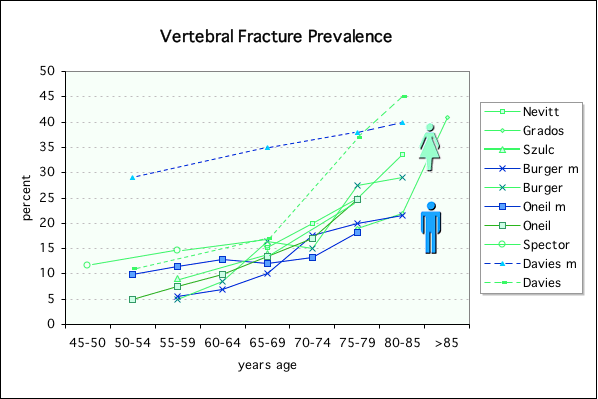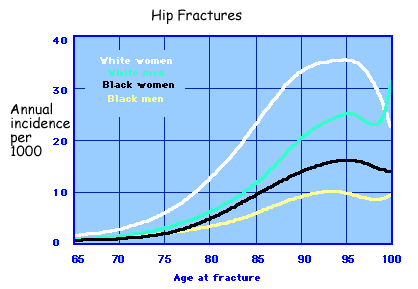 Click here to see no-Flash version
Click here to see no-Flash versionIn the USA, about 45% of postmenopausal women have low bone density. The lifetime risk of a fracture of the hip, spine or forearm is 40% in white women and 13% in white men. African-Americans have fewer fractures than people of other races. Worldwide the rates of osteoporosis are variable, but in every country age is one of the most important risk factors. As more people live longer lives, the number of those with osteoporosis will also increase. (Melton). In some countries, the rate of hip fractures is rising faster than the population. For example, in Malmo, Sweden the number of people older than 50 doubled since 1950, but the number of hip fractures increased seven-fold. The reasons for this secular trend in increased hip fractures are not known, but decreased physical activity may be playing a role.
The data are from people who live in Minnesota (Melton).
 Click here to see no-Flash version
Click here to see no-Flash version
Incidence and prevalence of vertebral fractures are much more difficult to ascertain than of hip fractures, because so many patients are unaware of the fractures. Epidemiological studies must involve lateral spine xrays. To make matters more complex, the degree of compression necessary to define a vertebral fracture is not standardized.
 Click to read more about defining vertebral fractures!
Click to read more about defining vertebral fractures!

 Click to highlight results from EVOS (European Vertebral Osteoporosis Study)
Click to highlight results from EVOS (European Vertebral Osteoporosis Study)
 See results of women only
See results of women only
 See all results
See all results
 See a table of studies
See a table of studies
 See a graph of fracture incidence
See a graph of fracture incidence

This graph shows rates in the USA in 1984-87, adapted from Jacobsen, SJ in American J Public Health 80:872, 1990.
In the USA, a white woman has a 17% chance of getting a hip fracture in her lifetime; a white man has a 6% chance. As seen in the graph above, the incidence of these hip fractures increases exponentially with age. Important racial differences in both bone mass and prevalence of fractures are seen. Persons of African descent have higher bone mass and lower rates of fractures. Asian women have lower bone mass than Caucasian women, but, interestingly, the rate of hip fractures is not proportionally higher. Theories to explain this discrepancy include shorter hip-axis length in the Asian women, previous activity levels that were higher, or the cultural practice of taking care of the elderly and not allowing them to leave their beds, reducing the opportunity for falling. Hispanic women had approximately half as many fractures as Caucasian women, but this is not explained by any difference in bone density.
Move your mouse over the map to see the incidence of hip fracture.
 Click here to see no-Flash version
Click here to see no-Flash version
 Click to see a table of the data about the incidence rates. They are calculated using different methods, which is why I normalized them all to the rates in Sweden. The risk in India is estimated from Indian persons in Singapore.
Click to see a table of the data about the incidence rates. They are calculated using different methods, which is why I normalized them all to the rates in Sweden. The risk in India is estimated from Indian persons in Singapore.

